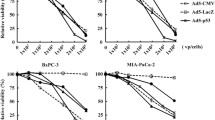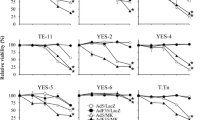Abstract
Pancreatic carcinoma is relatively resistant to chemotherapy and cell death induced by replication of adenoviruses (Ad) can be one of the therapeutic options. Transduction efficacy of conventional type 5 Ad (Ad5) is however low and the cytotoxic mechanism by replication-competent Ad was not well understood. We constructed replication-competent Ad5 of which the E1A promoter region was replaced with a transcriptional regulatory region of the midkine, the survivin or the cyclooxygenase-2 gene, all of which were expressed at a high level in human tumors. We also prepared replication-competent Ad5 that were activated with the same region but had the type 35 Ad-derived fiber-knob region (AdF35) to convert the major cellular receptor for Ad infection from the coxsackie adenovirus receptor to CD46 molecules. Replication-competent AdF35 that were activated with the exogenous region produced cytotoxic effects on human pancreatic carcinoma cells greater than the corresponding Ad5 bearing with the same regulatory region. Cells infected with the AdF35 showed cytopathic effects and increased sub-G1 fractions. Caspase-9, less significantly caspase-8 and poly (ADP-ribose) polymerase, but not caspase-3 was cleaved and expression of molecules involved in autophagy and caspase-independent cell death pathways remained unchanged. Nevertheless, H2A histone family member X molecules were phosphorylated, and N-acetyl-l-cystein, an inhibitor for reactive oxygen species, suppressed the AdF35-mediated cytotoxicity. These data indicated a novel mechanism of Ad-mediated cell death and suggest a possible clinical application of the fiber-knob modified Ad.







Similar content being viewed by others
Abbreviations
- Ad:
-
Adenoviruses
- Sur:
-
Survivin
- MK:
-
Midkine
- COX-2:
-
Cyclooxygenase-2
- Ad5:
-
Type 5 adenoviruses
- CAR:
-
Coxsackie adenovirus receptor
- AdF35:
-
Type 5 adenoviruses bearing type 35-derived fiber-knob region
- ROS:
-
Reactive oxygen species
- CMV:
-
Cytomegalovirus
- GFP:
-
Green fluorescent protein
- Lac:
-
β-galactosidase
- Vp:
-
Virus particles
- MOI:
-
Multiplicity of infection
- NAC:
-
N-acetyl-l-cysteine
- PARP:
-
Poly (ADP-ribose) polymerase
- H2AX:
-
H2A histone family member X
- IC50 :
-
Half maximal inhibitory concentration
References
Gresham GK, Wells GA, Gill S, Cameron C, Jonker DJ (2014) Chemotherapy regimens for advanced pancreatic cancer: a systematic review and network meta-analysis. BMC Cancer 14:471
Liu SX, Xia ZS, Zhong YQ (2014) Gene therapy in pancreatic cancer. World J Gastroenterol 20:13343–13368
Shimada H, Matsubara H, Shiratori T, Shimizu T, Miyazaki S, Okazumi S et al (2006) Phase I/II adenoviral p53 gene therapy for chemoradiation resistant advanced esophageal squamous cell carcinoma. Cancer Sci 97:554–561
Asaoka K, Tada M, Sawamura Y, Ikeda J, Abe H (2000) Dependence of efficient adenoviral gene delivery in malignant glioma cells on the expression levels of the Coxsackievirus and adenovirus receptor. J Neurosurg 92:1002–1008
Kasuya H, Takeda S, Nomoto S, Nakao A (2005) The potential of oncolytic virus therapy for pancreatic cancer. Cancer Gene Ther 12:725–736
Wold WS, Toth K (2013) Adenovirus vectors for gene therapy, vaccination and cancer gene therapy. Curr Gene Ther 13:421–433
Kawamura K, Yu L, Tomizawa M, Shimozato O, Ma G, Li Q et al (2007) Transcriptional regulatory regions of the survivin gene activate an exogenous suicide gene in human tumors and enhance the sensitivity to a prodrug. Anticancer Res 27:89–93
Miyauchi M, Yoshida Y, Tada Y, Narita M, Maeda T, Bahar R et al (2001) Expression of herpes simplex virus-thymidine kinase gene controlled by a promoter region of the midkine gene confers selective cytotoxicity to ganciclovir in human carcinoma cells. Int J Cancer 91:723–727
Yamamoto M, Alemany R, Adachi Y, Grizzle WE, Curiel DT (2001) Characterization of the cyclooxygenase-2 promoter in an adenoviral vector and its application for the mitigation of toxicity in suicide gene therapy of gastrointestinal cancers. Mol Ther 3:385–394
Sharma A, Li X, Bangari DS, Mittal SK (2009) Adenovirus receptors and their implications in gene delivery. Virus Res 143:184–194
Pong RC, Lai YJ, Chen H, Okegawa T, Frenkel E, Sagalowsky A et al (2003) Epigenetic regulation of coxsackie and adenovirus receptor (CAR) gene promoter in urogenital cancer cells. Cancer Res 63:8680–8686
Anderson BD, Nakamura T, Russell SJ, Peng KW (2004) High CD46 receptor density determines preferential killing of tumor cells by oncolytic measles virus. Cancer Res 64:4919–4926
Yu L, Takenobu H, Shimozato O, Kawamura K, Nimura Y, Seki N et al (2005) Increased infectivity of adenovirus type 5 bearing type 11 or type 35 fibers to human esophageal and oral carcinoma cells. Oncol Rep 14:831–835
Yamasaki Y, Tazawa H, Hashimoto Y, Kojima T, Kuroda S, Yano S et al (2012) A novel apoptotic mechanism of genetically engineered adenovirus-mediated tumour-specific p53 overexpression through E1A-dependent p21 and MDM2 suppression. Eur J Cancer 48:2282–2291
Hasei J, Sasaki T, Tazawa H, Osaki S, Yamakawa Y, Kunisada T et al (2013) Dual programmed cell death pathways induced by p53 transactivation overcome resistance to oncolytic adenovirus in human osteosarcoma cells. Mol Cancer Ther 12:314–325
Kroemer G, Martin SJ (2005) Caspase-independent cell death. Nat Med 11:725–730
Tait SW, Green DR (2008) Caspase-independent cell death: leaving the set without the final cut. Oncogene 27:6452–6461
Kitagawa K, Niikura Y (2008) Caspase-independent mitotic death (CIMD). Cell Cycle 7:1001–1005
Cabon L, Galán-Malo P, Bouharrour A, Delavallée L, Brunelle-Navas MN, Lorenzo HK et al (2012) BID regulates AIF-mediated caspase-independent necroptosis by promoting BAX activation. Cell Death Differ 19:245–256
Podhorecka M, Skladanowski A, Bozko P (2010) H2AX phosphorylation: its role in DNA damage response and cancer therapy. J Nucleic Acids 2010:920161
He D, Sun L, Li C, Hu N, Sheng Y, Chen Z et al (2014) Anti-tumor effects of an oncolytic adenovirus expressing hemagglutinin-neuraminidase of Newcastle disease virus in vitro and in vivo. Viruses 6:856–874
Kim CK, Ahmed AU, Auffinger B, Ulasov IV, Tobias AL, Moon KS et al (2013) N-acetylcysteine amide augments the therapeutic effect of neural stem cell-based antiglioma oncolytic virotherapy. Mol Ther 21:2063–2073
Cherubini G, Petouchoff T, Grossi M, Piersanti S, Cundari E, Saggio I (2006) E1B55K-deleted adenovirus (ONYX-015) overrides G1/S and G2/M checkpoints and causes mitotic catastrophe and endoreduplication in p53-proficient normal cells. Cell Cycle 5:2244–2252
Parreño M, Casanova I, Céspedes MV, Vaqué JP, Pavón MA, Leon J et al (2008) Bobel-24 and derivatives induce caspase-independent death in pancreatic cancer regardless of apoptotic resistance. Cancer Res 68:6313–6323
Acknowledgments
This study was supported by Grants-in-Aid for Scientific Research from the Ministry of Education, Culture, Sports, Science and Technology of Japan, the Grant-in-Aid for Research on seeds for Publicly Essential Drugs and Medical Devices from the Ministry of Health, Labor and Welfare of Japan, and a Grant-in-aid from the Nichias Corporation.
Author information
Authors and Affiliations
Corresponding author
Ethics declarations
Conflict of interest
The authors declare that there is no conflict of interests in this research.
Human and animal rights and informed consent
This research does not contain any of human participants or animals.
Rights and permissions
About this article
Cite this article
Yamauchi, S., Kawamura, K., Okamoto, S. et al. Replication-competent adenoviruses with the type 35-derived fiber-knob region achieve reactive oxygen species-dependent cytotoxicity and produce greater toxicity than those with the type 5-derived region in pancreatic carcinoma. Apoptosis 20, 1587–1598 (2015). https://doi.org/10.1007/s10495-015-1171-8
Published:
Issue Date:
DOI: https://doi.org/10.1007/s10495-015-1171-8




